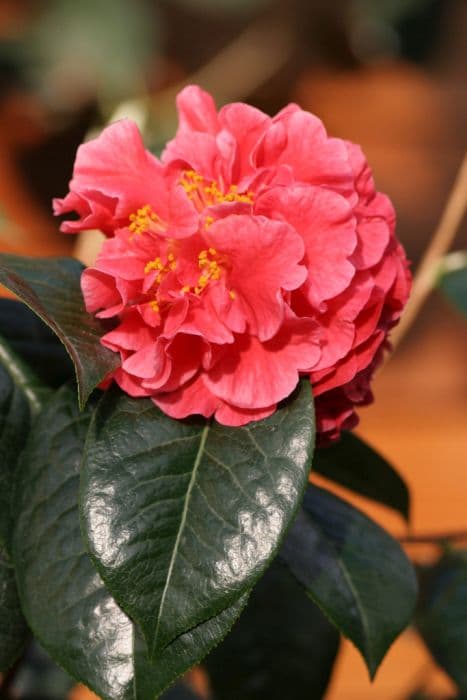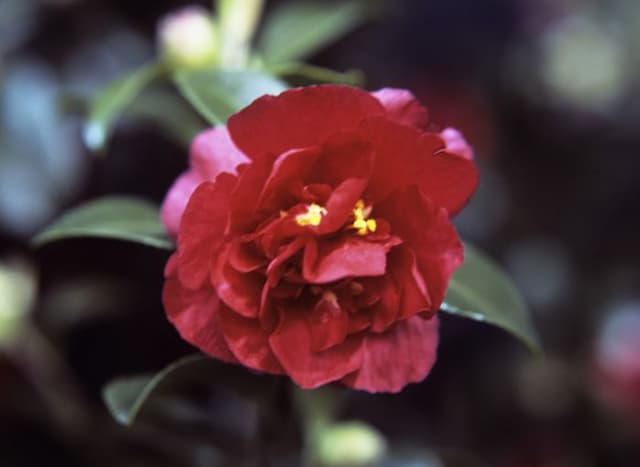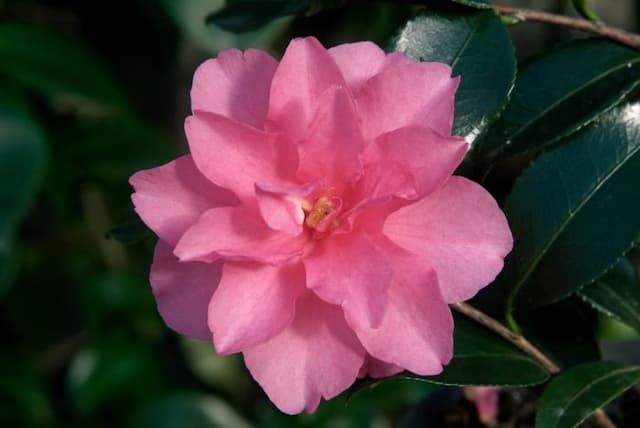Williamsii Camellia Camellia × williamsii 'George Blandford'

ABOUT
The Camellia × williamsii 'George Blandford' is an ornamental plant known for its attractive flowers and glossy foliage. It features a dense, evergreen habit, with leaves that are dark green and glossy, offering a striking backdrop to its blossoms. The leaves are leathery to the touch and have a slightly serrated edge, which gives them a refined appearance. The standout feature of this variety is its flowers. 'George Blandford' produces large, showy blooms that are a delight to behold. The petals are broad and overlapping, often with a ruffled or slightly waved margin, adding to their decorative effect. These flowers come in shades that range from pale pink to a deeper rose, with some variations including a gradient of hues within the same bloom. Inside the flower, there is a prominent set of contrasting golden-yellow stamens, which creates a beautiful contrast against the delicate petals. The blooms tend to appear in abundance from late winter to early spring, providing a much-appreciated splash of color during a time when many other plants are still dormant. The overall aesthetic of the Camellia × williamsii 'George Blandford' is one of classic elegance, making it a popular choice for gardens where a touch of formal beauty is desired. It is often used in plantings that accentuate its sophisticated blooms, such as in borders, as a specimen plant, or even in large containers where its ornamental qualities can be admired up close.
About this plant
 Names
NamesFamily
Theaceae
Synonyms
Williams' Camellia, George Blandford Camellia
Common names
Camellia × williamsii 'George Blandford'.
 Toxicity
ToxicityTo humans
Camellia 'George Blandford' is not considered toxic to humans. There are no well-documented reports of poisoning from ingesting parts of this plant.
To pets
Camellia 'George Blandford' is generally considered non-toxic to pets. It is not known to cause any significant poisoning symptoms if ingested by animals such as cats and dogs.
 Characteristics
CharacteristicsLife cycle
Perennials
Foliage type
Evergreen
Color of leaves
Dark green
Flower color
Pink
Height
6-10 feet [1.8-3 meters]
Spread
6-10 feet [1.8-3 meters]
Plant type
Shrub
Hardiness zones
7
Native area
Asia
Benefits
 General Benefits
General Benefits- Ornamental Appeal: 'George Blandford' offers aesthetic value with its bright and colorful flowers that enhance the visual appeal of gardens and landscapes.
- Long Flowering Period: This variety typically enjoys a lengthy blooming season, providing an extended display of its attractive blossoms.
- Drought Tolerance: Once established, 'George Blandford' has a degree of tolerance against drought, reducing the need for frequent watering.
- Cold Resistance: It is hardy in appropriate zones, able to withstand cooler temperatures, which makes it suitable for a range of climates.
- Pollen Source: The flowers provide a source of pollen for bees and other pollinating insects, supporting local ecosystems.
- Shade Tolerance: 'George Blandford' can tolerate partial shade, allowing it to be planted in a variety of garden settings and light conditions.
- Low Maintenance: Once established, it requires minimal pruning and care, making it suitable for gardeners of all skill levels.
 Medical Properties
Medical PropertiesThis plant is not used for medical purposes.
 Air-purifying Qualities
Air-purifying QualitiesThis plant is not specifically known for air purifying qualities.
 Other Uses
Other Uses- Camellia × williamsii 'George Blandford', commonly known as Camellia, is sometimes used as an additive in specialty fertilizers, with the nutrient-rich leaves acting as a natural supplement for plant growth.
- The waxy leaves of Camellias can be used in floral arrangements, providing a glossy, deep green backdrop that enhances the overall appearance of the bouquet.
- Captured rainwater from Camellia leaves is occasionally collected by gardeners for watering sensitive plants, as it is slightly acidic and can be beneficial for certain plants that prefer lower pH levels.
- In some regions, dried and pulverized Camellia leaves are used as a natural dye for fabrics, yielding a range of colors from green to brown depending on the treatment process.
- The strong wood of Camellia is occasionally carved into small decorative items or used in the crafting of fine woodworking projects, like inlays and marquetry.
- Camellia petals can be pressed and used in crafts such as handmade papers or botanical prints, providing an artistic use for fallen flowers.
- Some gardeners use the dense, evergreen nature of Camellia bushes for privacy hedges or windbreaks in their landscapes, taking advantage of their thick foliage.
- Camellia is sometimes incorporated into perfumery, where its subtle fragrance can be extracted and worked into scented products like candles or sachets.
- The acid-loving nature of Camellias allows them to be planted beneath pine trees, where other plants might not thrive due to the acidic pine needles that drop to the ground.
- Beekeepers occasionally value Camellias for their late-season flowers which provide bees with nectar and pollen sources when other flowers have ceased blooming.
Interesting Facts
 Feng Shui
Feng ShuiCamellia is not used in Feng Shui practice.
 Zodiac Sign Compitability
Zodiac Sign CompitabilityCamellia is not used in astrology practice.
 Plant Symbolism
Plant Symbolism- Admiration: The Camellia often symbolizes admiration and is given as a gesture to express one's glowing opinion of another.
- Perfection: This flower's exquisite beauty and form represent perfection and is ideal for conveying flawless excellence.
- Gratitude: Giving a Camellia can mean a way of saying thank you, as it is associated with the expression of gratitude.
- Longevity: Camellias are known to live for many years, so they also symbolize longevity and enduring quality.
- Love: Camellias represent love, especially the 'George Blandford' which, with its beautiful petals, might be seen as embodying the pure and unselfish nature of love.
- Refinement: With its elegant appearance, the Camellia often stands for refined beauty and grace.
 Water
WaterThe Williamsii Camellia should be watered to keep the soil evenly moist but not waterlogged. During the growing season, typically from spring through fall, water the plant with about 1 to 1.5 gallons per week, depending on weather conditions. In hotter, drier periods, you may need to water more frequently, while in cooler, damp conditions, less water is required. Always check the top inch of the soil for dryness before watering. In the winter, water sparingly, just enough to prevent the soil from drying out completely.
 Light
LightWilliamsii Camellias prefer dappled light or partial shade; avoid placing them in direct afternoon sunlight which can scorch their leaves. The ideal spot for these plants is an eastern or northern exposure that receives morning light and protects them from the harsh afternoon sun. They thrive under the light shade of tall trees that provide a canopy of filtered sunlight.
 Temperature
TemperatureWilliamsii Camellias are cold hardy and can tolerate temperatures as low as 10°F but perform best in temperatures ranging from 50-80°F. They should be protected from harsh winter winds and extreme cold which can damage the foliage and blooms. During hot summer months, ensure they are shielded from excessive heat by providing shade or mulch to keep the root system cool.
 Pruning
PruningPrune Williamsii Camellias to maintain shape and remove any dead or weak branches; pruning is also beneficial for encouraging air circulation within the plant. The best time to prune is immediately after the flowers have finished blooming in spring. Prune sparingly, as heavy pruning can reduce flowering the following season. Any necessary shaping or size reduction should be done at this time.
 Cleaning
CleaningAs needed
 Soil
SoilThe Williamsii camellia requires acidic soil with a pH range of 5.5 to 6.5. A mix of equal parts well-draining acidic potting soil, peat moss, and pine bark is ideal for optimal growth.
 Repotting
RepottingWilliamsii camellias generally need repotting every 2 to 3 years, preferably in the spring before the growing season begins.
 Humidity & Misting
Humidity & MistingWilliamsii camellias thrive with high humidity, ideally between 50% and 60%, to maintain healthy growth and lush foliage.
 Suitable locations
Suitable locationsIndoor
Place Williamsii camellia in bright, filtered light with high humidity.
Outdoor
Shelter Williamsii camellia from strong sun, in well-drained acidic soil.
Hardiness zone
7-9 USDA
 Life cycle
Life cycleThe life cycle of Camellia × williamsii 'George Blandford', commonly known as a Williamsii hybrid camellia, begins with seed germination, usually in a moist, well-drained environment, although propagation is more commonly achieved through cuttings to maintain cultivar traits. As a juvenile plant, it focuses on root and foliage development, typically displaying glossy, dark green leaves. The plant matures over several years and begins flowering, often in late winter or spring, showcasing large, showy flowers that can range in color. Following pollination, if fertile, the camellia produces dry capsules containing seeds, though cultivated varieties are often propagated vegetatively. Each growing season, the evergreen shrub undergoes vegetative growth, with older camellias reaching substantial sizes over time, potentially up to 2.5 meters in height and width. The plant's life cycle continues with yearly blooming and growth, and with proper care, Camellia × williamsii 'George Blandford' can live and thrive for many decades.
 Propogation
PropogationPropogation time
Spring-Early Summer
Camellia × williamsii 'George Blandford', commonly known as the Camellia, is most commonly propagated by semi-hardwood cuttings. This method is typically done in late summer after the season's new growth has begun to harden. You would take cuttings of about 4 to 6 inches long from the current year's growth, ensuring each cutting has at least two to three leaf nodes. The lower leaves are usually removed, and the cut end can be dipped in rooting hormone powder to enhance root formation. These prepared cuttings are then inserted into a pot filled with a mix of peat and perlite or a similar well-draining propagation medium. The pots are then placed in a shaded area and kept moist until roots develop, which usually takes several weeks to a few months. To maintain high humidity, you can cover the pot with a plastic bag or place it in a propagator.









